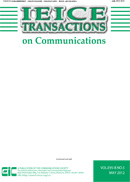
- |<
- <
- 1
- >
- >|
-
Po-Heng CHOUArticle type: PAPER
Subject area: Fundamental Theories for Communications
2020Volume E103.BIssue 2 Pages 103-117
Published: February 01, 2020
Released on J-STAGE: February 01, 2020
Advance online publication: July 26, 2019JOURNAL RESTRICTED ACCESSBased on the License Assisted Access (LAA) small cell architecture, the LAA coexisting with Wi-Fi heterogeneous networks provide LTE mobile users with high bandwidth efficiency as the unlicensed channels are shared among LAA and Wi-Fi. However, the LAA and Wi-Fi will affect each other when both systems are using the same unlicensed channel in the heterogeneous networks. In such a network, unlicensed band allocation for LAA and Wi-Fi is an important issue that may affect the quality of service (QoS) of both systems significantly. In this paper, we propose an analytical model and conduct simulation experiments to study two allocations for the unlicensed band: unlicensed full allocation (UFA), unlicensed time-division allocation (UTA), and the corresponding buffering mechanism for the LAA data packets. We evaluate the performance for these unlicensed band allocations schemes in terms of the acceptance rate of both LAA and Wi-Fi packet data in LAA buffer queue. Our study provides guidelines for designing channel occupation phase and the buffer size of LAA small cell.
View full abstractDownload PDF (1079K) -
Yusaku ITO, Yojiro MORI, Hiroshi HASEGAWA, Ken-ichi SATOArticle type: PAPER
Subject area: Fiber-Optic Transmission for Communications
2020Volume E103.BIssue 2 Pages 118-129
Published: February 01, 2020
Released on J-STAGE: February 01, 2020
Advance online publication: July 26, 2019JOURNAL FREE ACCESSA novel coarse and fine hybrid granular routing network architecture is proposed. Virtual direct links (VDLs) defined by the coarse granular routing to bridge distant node pairs, and routing via VDL mitigate the spectrum narrowing caused by optical filtering at wavelength-selective switches in ROADM (Reconfigurable Optical Add/Drop Multiplexing) nodes. The impairment mitigation yields denser channel accommodation in the frequency domain, which substantially increases fiber spectral efficiency. The proposed network simultaneously utilizes fine granular optical path level routing so that optical paths can be effectively accommodated in VDLs. The newly developed network design algorithm presented in this paper effectively implements routing and spectrum assignment to paths in addition to optimizing VDL establishment and path accommodation to VDLs. The effectiveness of the proposed architecture is demonstrated through both numerical and experimental evaluations; the number of fibers necessary in a network, and the spectrum bandwidth and hop count product are, respectively, reduced by up to 18% and increased by up to 111%.
View full abstractDownload PDF (3487K) -
Ryotaro OHASHI, Takashi TOMURA, Jiro HIROKAWAArticle type: PAPER
Subject area: Antennas and Propagation
2020Volume E103.BIssue 2 Pages 130-138
Published: February 01, 2020
Released on J-STAGE: February 01, 2020
Advance online publication: August 22, 2019JOURNAL RESTRICTED ACCESSThis paper presents the excitation coefficient optimization of slot array antennas for increasing channel capacity in 2×2-mode two-dimensional ROM (rectangular coordinate orthogonal) transmission. Because the ROM transmission is for non-far region communication, the transmission between Tx (transmission) and Rx (reception) antennas increases when the antennas radiate beams inwardly. At first, we design the excitation coefficients of the slot arrays in order to enhance the transmission rate for a given transmission distance. Then, we fabricate monopulse corporate-feed waveguide slot array antennas that have the designed excitation amplitude and phase in the 60-GHz band for the 2×2-mode two-dimensional ROM transmission. The measured transmission between the fabricated Tx and Rx antennas increases at the given propagation distance and agrees with the simulation.
View full abstractDownload PDF (4926K) -
Jain-Shing LIU, Chun-Hung LINArticle type: PAPER
Subject area: Terrestrial Wireless Communication/Broadcasting Technologies
2020Volume E103.BIssue 2 Pages 139-147
Published: February 01, 2020
Released on J-STAGE: February 01, 2020
Advance online publication: July 26, 2019JOURNAL RESTRICTED ACCESSIn this work, we address a joint energy efficiency (EE) and throughput optimization problem in interweave cognitive radio networks (CRNs) subject to scheduling, power, and stability constraints, which could be solved through traffic admission control, channel allocation, and power allocation. Specifically, the joint objective is to concurrently optimize the system EE and the throughput of secondary user (SU), while satisfying the minimum throughput requirement of primary user (PU), the throughput constraint of SU, and the scheduling and power control constraints that must be considered. To achieve these goals, our algorithm independently and simultaneously makes control decisions on admission and transmission to maximize a joint utility of EE and throughput under time-varying conditions of channel and traffic without a priori knowledge. Specially, the proposed scheduling algorithm has polynomial time efficiency, and the power control algorithms as well as the admission control algorithm involved are simply threshold-based and thus very computationally efficient. Finally, numerical analyses show that our proposals achieve both system stability and optimal utility.
View full abstractDownload PDF (993K)
- |<
- <
- 1
- >
- >|